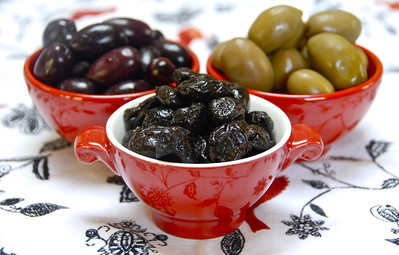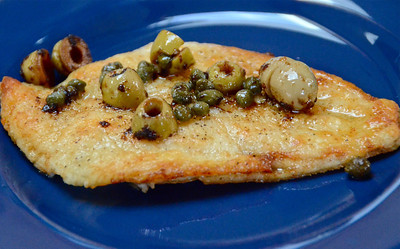
For as long as I can remember, I’ve loved olives. As a little kid, I’d sneak into my parents’ kitchen, clamber up on the counter, and slide a container of black olives from the top cupboard shelf. Bounty procured, I’d consume every single salty olive in that can. Oh, the joy! Oh, the upset stomach! No matter how violently ill olive binging made me, I’d be back a few days later, pulling yet another can off the shelf.
At that time I knew very little about olives. Didn’t understand that they were fruit from the Mediterranean. Also unaware that black olives were actually ripe green olives that had, in all likelihood, been lye-cured. This curing process gave them their velvety texture and mild, oily taste. It also made them a sheer delight to eat.
Whenever I craved more complex flavors, I’d raid the refrigerator for a jar of pimento-stuffed olives. To an uncultured elementary schooler, green olives filled with red ribbons of pepper were the height of culinary sophistication. I mean, really—how could food get any more festive, fancy or flavorful than that?
Decades later I can’t resist France’s slightly tart, green Picholines and Nicoises. Nor can I pass on Greece’s purple Kalamatas and dark green Naphlions. I’m even hooked on the bold, dry-cured, black olives from Morocco. Packed in salt, dry-cured olives possess withered flesh and a stronger taste than those cured in water, brine or lye.

Picholine Sole
In the ensuing years I’ve learned that I can do a lot more with olives than eat them from a jar or can. I can use them to perk up sauces and tajines, enliven fish and poultry and make fabulous tapenades. When stuffed with ground meats, breaded and then pan-fried, they become the hearty appetizers known as olive all’ Ascolana. The Le Marche region of Italy is famous for this filling treat.
While my tastes have become more sophisticated and my options broader, I remain, at heart, an elementary school kid. My favorite way to consume olives remains straight from the container.
PICHOLINE SOLE
Serves 4
2 tablespoons unsalted butter
1 tablespoon olive oil
1/4 cup unbleached all-purpose flour
4 (4 to 6-ounce) sole fillets
Sea salt, to taste
Freshly ground black pepper, to taste
1/3 cup green Picholine olives, halved
2 tablespoons freshly squeezed lemon juice
In a large nonstick frying or sauté pan heat the butter and oil on medium. Spread the flour onto a small plate.
Season the fillets with salt and pepper. Dredge the sole through the flour, coating both sides.
Lay the fish skin-side down in the pan and cook for 3 minutes, until the skin browns and the flesh begins to turn white around the edges. Flip the fish over, add the olives, swirling them around the pan, and cook for 2 to 3 minutes, until the sole is flaky and cooked through. Place the fish on a serving platter and cover to keep warm.
Add the two tablespoons of lemon juice to the hot pan and swirl the ingredients around to blend. Pour the olive sauce over the fish and serve immediately.